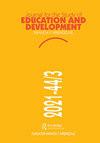Tool selection based on rigidity in young children: a comparative approach (Selección de herramientas en función de su rigidez con niños preescolares: un enfoque comparativo)
IF 1.8
4区 教育学
Q4 PSYCHOLOGY, DEVELOPMENTAL
Journal for the Study of Education and Development
Pub Date : 2022-01-06
DOI:10.1080/02103702.2021.2000128
引用次数: 0
Abstract
ABSTRACT Fifty-one 23-to-55-month-old-infants faced two apparatuses that required the use of a rigid (box apparatus) or flexible (hose apparatus) stick-like tool to retrieve a toy stuck inside. Before attempting the extraction, however, they had to pick the only one tool (of three) on display that had the appropriate rigidity/flexibility to be effective. To inform their decisions, they could either manipulate the three tools themselves (haptic information) or observe the experimenter bending and unbending them for just five seconds each (visual information) before selection. Children found more difficulties in selecting appropriate flexible tools, as compared to rigid ones. Moreover, infants’ own haptic inspection of each tool did not significantly improve their selection accuracy, which indicates that observing the experimenter’s demonstration conveyed all the information required to make correct choices.基于幼儿刚性的工具选择:一种比较方法(基于幼儿刚性的工具选择:一种比较方法)
51名23 ~ 55个月大的婴儿面对两种器械,需要使用刚性(盒状器械)或柔性(软管状器械)棒状工具来取出卡在其中的玩具。然而,在尝试提取之前,他们必须在展示的三种工具中选择一种具有适当刚性/灵活性的有效工具。为了让他们做出决定,他们可以自己操纵这三种工具(触觉信息),或者在选择之前观察实验者弯曲和松开它们的五秒钟(视觉信息)。与刚性工具相比,孩子们在选择合适的柔性工具时遇到了更多的困难。此外,婴儿自己对每个工具的触觉检查并没有显著提高他们的选择准确性,这表明观察实验者的演示传达了做出正确选择所需的所有信息。
本文章由计算机程序翻译,如有差异,请以英文原文为准。
求助全文
约1分钟内获得全文
求助全文

 求助内容:
求助内容: 应助结果提醒方式:
应助结果提醒方式:


